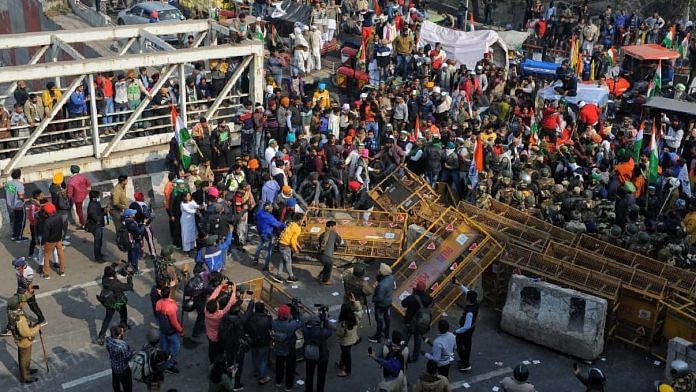New Delhi: “Police are attacking peaceful protestors using tear gas, batons and water canons. Hundreds injured, many disappeared and many individuals are reported dead.”
“Police have also cut food and fresh water supplies in an attempt to starve people @IndianFarmers_ @UNHumanRights are you watching?”
These were some of social media post templates that the Delhi Police came across in a communication package (CommsPack), or toolkit, on the farmers’ protest, allegedly designed by activist Shantanu Muluk, who has been arrested in connection with the formulation of the toolkit.
The Delhi Police has claimed that the toolkit was used for inciting disaffection against India. Muluk faces charges of sedition, promoting hatred among various communities and criminal conspiracy.
Opposing his plea for regular bail, the Delhi Police in an affidavit described these ready-made templates as “potent tools for spreading false rumours that precipitate violence and create disorder”.
The police also drew similarities between the incident in the national capital on 26 January, when the protest turned violent at Red Fort and other places, and the Northeast Delhi riots in 2020. It also relied on a “few influential studies” to highlight the impact of false rumour spread through social media and the consequent communal and mob violence.
The police submitted its reply Tuesday in the court of additional sessions judge Dharmendra Rana, who is hearing Muluk’s bail plea.
On Tuesday, the judge extended protection for Muluk from arrest until the next hearing of his application on 15 March. The activist is on anticipatory bail in the case, following a 17 February order by the Bombay High Court.
In a related case, ASJ Rana on 23 February released climate activist Disha Ravi, who was arrested from Bengaluru for allegedly editing the same toolkit.
Like in Ravi’s case, the Delhi Police opposed Muluk’s bail on the ground that the toolkit had a link to the website “GenocideWatch.Org”, which allegedly promotes hatred and contempt against India.
However, rejecting this evidence against Ravi, the court had held the said material uploaded on the portal “may be false or even exaggerated” but not seditious.
Also read: News portals challenge new Modi govt rules for digital media, say it’s beyond scope of IT Act
What the Delhi Police claims
On the charges against Muluk, the Delhi Police in its affidavit claimed he had a direct role to play in the planning, finalisation and execution of a large, inter-continental conspiracy to excite disaffection against India and defile the country’s image among Indians, NRIs and others.
As part of this conspiracy, Muluk collaborated with Poetic Justice Foundation to organise a series of actions centered on Republic Day, the police said.
Muluk actively participated in formulating the toolkit with automated, ready-to-post templates that were shared by millions of people and could be activated at the press of single click. These templates could be spread with “lightning-fast speed across the landscape, giving virtually no opportunity to counter it and rebut it”, submitted the police.
The contents in the templates were factually incorrect and were, thus, false rumour, the affidavit insisted. They were embedded with hashtags, “thus compounding their visibility and reach amongst the target audience”.
The police said an analysis has shown these false news templates were used to post and spread rumours in an already charged environment, where a large number of protestors had gathered on the borders of the national capital to participate in the tractor rally on Republic Day.
Also read: Mehbooba Mufti moves Delhi HC challenging ED summons in money laundering case
Impact of ‘false and true rumours’
Citing multiple social media research, the affidavit explained the impact of “false rumours”, which takes about 14 hours to be resolved in comparison as against a “true rumour” that gets resolved in two hours.
“There is a lag of 13 hours between publication of a false rumours and its reasonable debunking,” the affidavit said.
To stress its point, the police mentioned a series of tweets that were published on 1 March 2020, in the aftermath of the Northeast Delhi riots, containing false news of violence and fatalities, which snowballed within an hour into a major public order challenge, involving a large area of west, northwest, southwest and southeast Delhi.
As a result, markets were hurriedly shut, people panicked, colony gates were closed and manned by residents holding batons and sticks to ward off “imaginary violent mobs”, the affidavit said.
“The original false rumour was followed by multiple other rumours about riots and violence, causing even more panic, anxiety and communal tensions,” the affidavit added.
It was only due to fast, concerted efforts of police at all ranks that the false rumours were effectively countered and normalcy returned by late night, the police claimed.
The police urged the judge consider the timeline proposed in the toolkit and its recourse to the “tweet storm and digital strike followed by physical action and false rumour bombing” in the context of the research findings quoted in the affidavit.
“A simple social media post may seem innocuous when seen in isolation, but when the same false rumour is compounded, strengthened and legitimised by repeated sharing, it becomes a tinder box that is ready to explode and ignite large-scale violence,” the police added.
Also read: ‘No matter of doubt’: IM’s Ariz Khan convicted for killing inspector MC Sharma at Batla House



